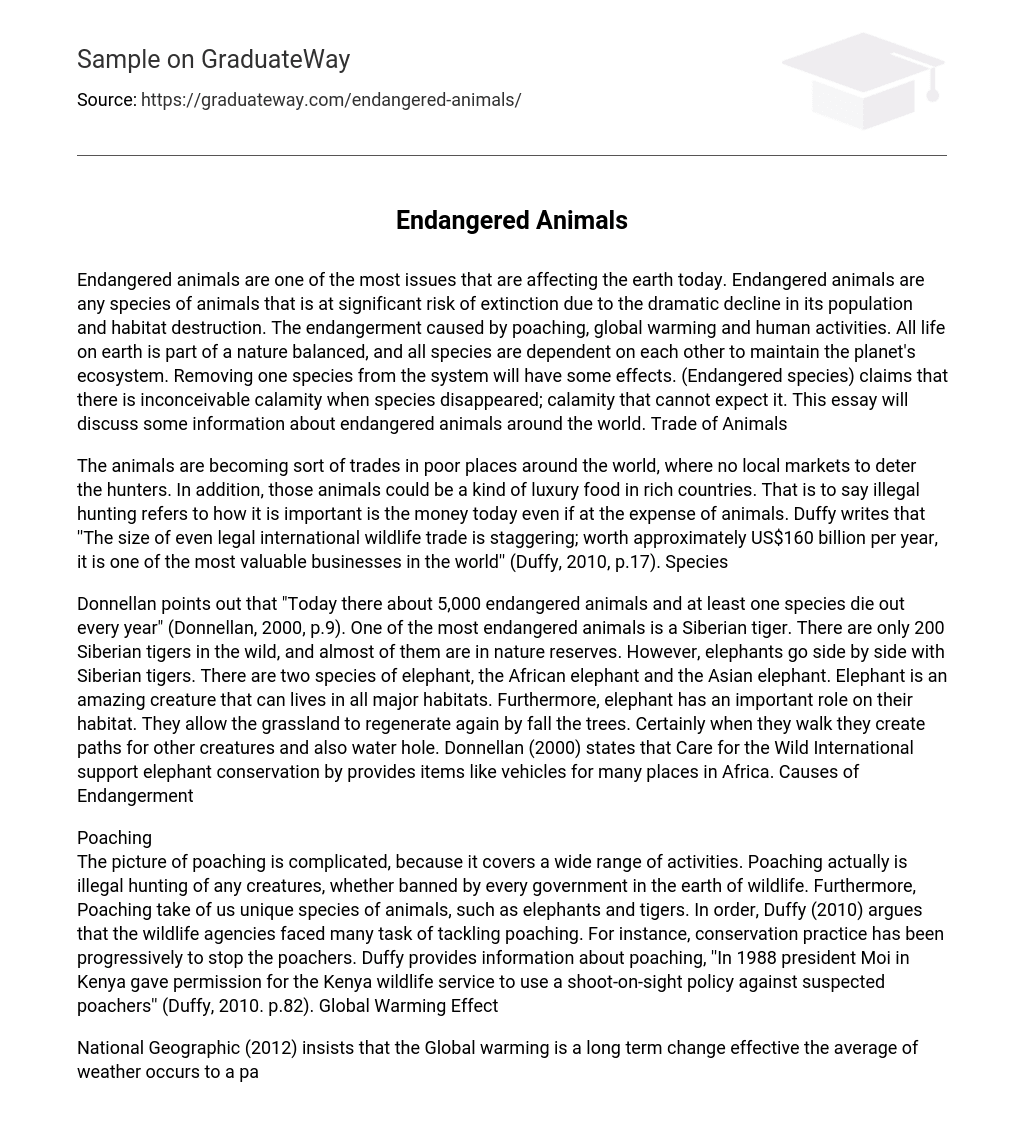Endangered animals are currently a significant concern for the Earth. They are at a high risk of extinction due to population decline and habitat destruction caused by poaching, global warming, and human activities. This is worrisome because the survival of all life on Earth depends on a balanced nature in which each species relies on one another to maintain the ecosystem. The removal of even a single species from this delicate system can have far-reaching consequences. According to Endangered Species, the extinction of a species results in an unforeseen catastrophe. This essay will explore various aspects of endangered animals globally, including animal trafficking.
In poorer areas of the world where there are no local markets to discourage hunters, animals are being treated as commodities. Additionally, in wealthier countries, these animals may be seen as luxury food items. This demonstrates how illegal hunting prioritizes money over the well-being of animals. Duffy (2010) highlights the immense scale of the legal international wildlife trade, estimating it to be worth around US$160 billion annually. This makes it one of the most lucrative industries globally (p.17). Species
According to Donnellan (2000), approximately 5,000 animals are currently at risk of extinction, with one species disappearing every year. This is especially worrisome for the Siberian tiger, as it is among the most critically endangered creatures. The wild population of Siberian tigers consists of only about 200 individuals and they are mainly found in nature reserves. Interestingly, elephants face a similar destiny. There are two distinct types of elephants: African and Asian elephants. Elephants possess an extraordinary ability to thrive in various habitats and play a crucial role in their ecosystems by rejuvenating grasslands through tree toppling and creating paths for other animals to navigate. In addition, they contribute to the formation of watering holes. Donnellan (2000) emphasizes that Care for the Wild International actively supports elephant conservation efforts by providing resources like vehicles across different locations in Africa. Therefore, it is imperative to address the factors that lead to their endangerment.
The issue of poaching is complex as it encompasses a wide range of activities. Poaching refers to the illegal hunting of any living creatures, which is banned by governments worldwide to protect wildlife. Poaching specifically targets unique animal species like elephants and tigers. According to Duffy (2010), wildlife agencies face numerous challenges in addressing poaching. One conservation practice to combat poaching is the implementation of a shoot-on-sight policy against suspected poachers, as was permitted by president Moi of Kenya for the Kenya wildlife service in 1988 (Duffy, 2010, p. 82). Another environmental concern is the impact of global warming.
According to National Geographic (2012), global warming is the long-term change in weather patterns of a particular area, caused by human activities such as burning fossil fuels in vehicles. The release of gases, particularly carbon dioxide, from cars has been deemed extremely dangerous. As a result, various effects on wildlife have been observed. Even a slight increase in temperature can lead to the melting of Arctic sea ice, Greenland’s ice sheets, and mountain glaciers that serve as habitats for many animal species. National Geographic (2012) emphasizes the dangers faced by polar bears, Arctic wolves, Arctic foxes, and seals due to these changes. Additionally, rising sea levels pose a significant threat to marine mammals that rely on ice for their survival.
Extinction is the permanent loss of a species, making it important to protect at-risk species. These animals need clean air, water, and suitable habitats with food to survive. To prevent endangered animals from disappearing forever, various approaches are being implemented.
Endangered species Conservation Organizations are actively working to raise awareness about extinction consequences. They advocate for creating nature reserves to safeguard animal habitats. Additionally, zoos have captive breeding programs aimed at preserving endangered populations.
As individuals, we can make significant contributions towards protecting endangered animals worldwide. One important action is reducing paper consumption as it directly affects forest habitats.
In conclusion,
The plant is responsible for producing vital resources required for human survival. Safeguarding animals can also contribute to the conservation of plant life, which is crucial for humans. Donnellan (2000) states that nearly 99% of endangered species are primarily threatened by human activities (p.63). Scientists are striving to mitigate the negative effects of human actions and restore habitats. Conservation organizations suggest measures to governments in order to safeguard endangered species from extinction, while governments possess the authority to enforce stringent laws as a deterrent against offenders.





